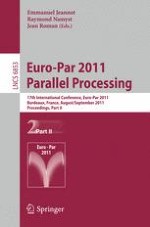The two-volume set LNCS 6852/6853 constitutes the refereed proceedings of the 17th International Euro-Par Conference held in Bordeaux, France, in August/September 2011. The 81 revised full papers presented were carefully reviewed and selected from 271 submissions. The papers are organized in topical sections on support tools and environments; performance prediction and evaluation; scheduling and load-balancing; high-performance architectures and compilers; parallel and distributed data management; grid, cluster and cloud computing; peer to peer computing; distributed systems and algorithms; parallel and distributed programming; parallel numerical algorithms; multicore and manycore programming; theory and algorithms for parallel computation; high performance networks and mobile ubiquitous computing.
